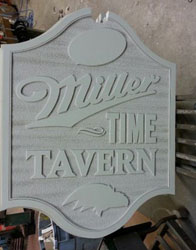When M&T Bank Stadium, home field of the NFL’s Baltimore Ravens, decided to set up the Miller Time Tavern on its grounds before the start of the 2014 pro football season, officials knew they were also going to need new signage accompanying it.
So one area sign company received the kickoff and returned this project for a business-winning score. In fact, their years of experience and family ties allowed them to make sure the signs they created here would be one for the highlight reels.
The new Miller Time Tavern is located outside the main gates of M&T Bank Stadium. During games, it serves as a bar. Ravens officials contacted Powers Creative, a design and creative consulting team based in Baltimore, requesting signs attached to the ironwork of the gate on the stadium grounds that would identify it.
Thanks to their close relationship on prior projects, Powers Creative turned to Shannon-Baum Signs & Graphics (www.shannonbaum.com) of Eldersburg, Maryland for help. The company produces custom signs, vehicle wraps, sandblasted and hand-painted signs, LED message centers, dimensional lettering, banners, ADA signs, and more mostly for governmental, retail, sign, advertising & marketing, property management, and construction companies in the Maryland, Delaware, Virginia, West Virginia, and D.C. regional areas.
Most of the company’s incoming projects can be attributed to repeat business and word-of-mouth referrals. They also have close relationships with other creative types in the area, such as Lyndi Carvalho and Kristin Powers of Powers Creative.

“We started working with them in 2010 on several signage projects, including Loyola University Maryland’s Ridley Athletic Complex,” says Vice President Denise Baum. “We enjoy collaborating with them on projects, as we are able to offer them the fabrication and installation of their sign and graphics needs.”
Shannon-Baum Signs & Graphics also has history on its side. The company is currently celebrating its sixty-fifth year in business. “We started as a mom-and-pop shop in 1950 in Baltimore and grew to become the largest manufacturer of traffic signs in Maryland,” says Denise. (Note: Denise is the granddaughter of the original owner, and her mother Jean, father Rick, uncle Don, brother Doug, and sister Kim all work at the company as well.)
The shop has certainly grown from its humble origins. Today thirty-two employees work out of a 36,000-square foot facility. In addition to office staff, these employees include designers, screen printers, fabricators, welders, installers, shop floor personnel, and delivery drivers.
“We look for friendly, team-oriented, creative, ambitious, and dependable candidates,” says Denise. “And we have experience! Our general manager, Jackie, has been with us for thirty years now, and many of our employees have been here for ten to twenty years.”
Shannon-Baum also has a reputation for providing quick turnarounds. Look around their shop floor and you’ll notice two fifty-four-inch and two sixty-inch Graphtec plotters, two sixty-inch Roland SOLJET eco-solvent wide format printers, a sixty-two-inch Seal Laminator, a five-by-ten-foot CNC router, an Orbital X ADA machine, screen printing equipment, a custom spray paint booth, and two metal shears. “Although we have automated equipment for making signs, this still remains a labor-intensive process,” says Denise.
For the Ravens project, the signs needed to be thick enough to go around the fence/gate, so Shannon-Baum employees visited the stadium ahead of fabrication to get custom measurements of each sign.
In the end, six 48-by-37-inch signs were mounted back-to-back on each side of the gates, as well as two 96-by-18-inch ones.
The eight sign panels were sandblasted out of one-and-a-half-inch-thick, eighteen-pound Sign•Foam high-density urethane material. “We like the strength one gets using eighteen-pound foam,” explains Denise. “And we find that Sign•Foam is superior to wood, since it’s rot- and mildew-resistant. It can also be repaired, if part of the sign becomes damaged (and these pieces located).”
The sign shop first rough-cut the Sign•Foam blanks with a jigsaw. They next applied Gorilla Glue® to adhere more foam onto the back of one sign face and utilized a sander with 80-grit sandpaper to finish shaping the sign. They then custom-cut notches to fit the fence, and blasted the image onto Sign•Foam via a sandblasting pot with #2 sand.

Then they employed brushes, spray guns, and a roller to paint the signage pieces with Ronan Bulletin Color paints. Including drying time, this took about a week.
Earlier Powers Creative had provided Shannon-Baum the artwork for the project, including the Ravens and Miller Lite® logos. The sign company printed these logos onto 3M IJ180CV3 vinyl using the SOLJET and laminated them with 3M 8519 Lustre overlaminate. They hand-applied the digitally printed vinyl to the flat, raised sections of the painted Sign•Foam blanks.
Deck screws and a screw gun were used for installing the signs onto the gate. The main challenge for the sign shop was making sure that, when mounted onto the black steel gates, these 1-1/2-inch-thick sandblasted signs would appear as one piece. “We used spacers on the sides to equal six inches thick when finished,” says Denise. “So from the sides, it appears as a one-piece sign.”
Denise says there were a couple of reasons her shop was excited to work on this project. For one, it was many of their employees’ favorite sports team. And second, it was the clients’ reaction. The Baltimore Ravens were thrilled with the signs, as was Powers Creative.
“Shannon-Baum did an excellent job interpreting our ideas to integrate the signage with the existing structure of the stadium gates,” says Kristin Powers. “We were looking for a ‘tavern’ feel with materials that would hold up to the environmental conditions of the stadium concourse.
“They delivered exactly that, and the color saturation and timeless look of the signs continually draw fans in to enjoy the space.”











